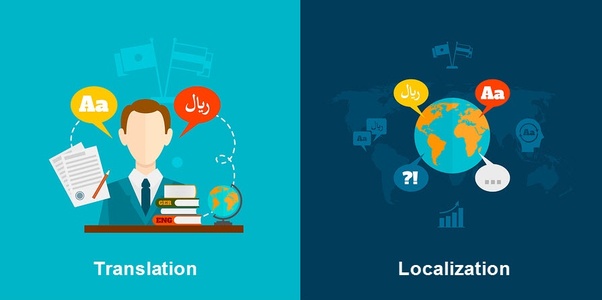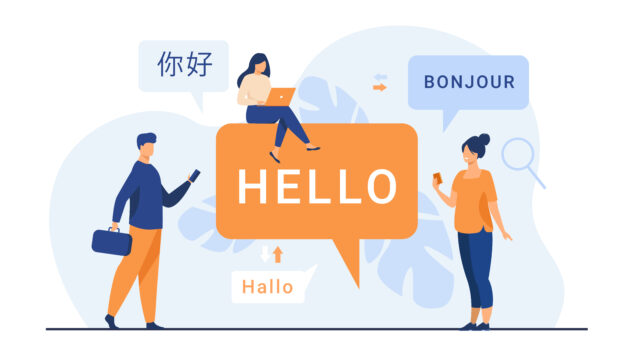Top Tips for Translation and Localization Marketing
We have all heard about translation, localization, and these days, transcreation. Yeah, whatever right? Someone is always coming up with a new and improved way to sell you on the latest variation of tried and true marketing techniques. However, what we will show you how to do is to use this tried and true method to build a successful digital marketing campaign, from the first phase of website translation to influencer marketing on YouTube and popular Social Media websites with stops virtually everywhere in between.
Ecommerce sales are increasing around the globe as people are forced to stay at home and seek online alternatives for work, play, and even their basic shopping needs in some cases. A report published on the twentieth of April, 2020 on the Visual Capitalist website shows just how stunning this increase in eCommerce sales statistics really is.
In item-specific terms, the sales of cleaning supplies and safety items increased exponentially. Among the largest increases were disposable gloves with an increase of 670%, bread machines going up 652%, with cough and cold medicine sales rising 535%.
Numerous dried goods and other easily stored products also saw a similar increase with soup sales going up 397%, dried grains including rice increasing some 38%, and packaged foods increasing by an equally amazing 377%.
Granted, these are not the items most small eCommerce marketers will be selling, but this and other similar reports point out that other markets are seeing similar increases, even if somewhat smaller in scale. There was, however, as is almost always the case, a caveat that should be noted as well.
The WooCommerce website has put together a comprehensive list of information and statistics for international eCommerce websites and sales. 70% of online consumers purchase from international retailers.
The average order value of international sales is $147 (US dollars) which is 17% higher than the average domestic eCommerce order. Among your competitors in eCommerce and digital marketing, 93% either plan to or already offer international commerce from their websites. In your internationalization efforts, website translation services also play a major role.
The caveat you ask? Customers want to view reviews in video format, with at least closed captioning in their own languages. Customers want to read reviews and learn about products in their own language. Customers also want to be able to pay for products in their own currency so that they know exactly how much an item costs.
In order to create a successful international eCommerce website, two of the most important factors will be translation and localization of the website and all of the relevant and associated content. Even then, however, there are some basic concepts to increase eCommerce success that may often be overlooked, so this article will walk through some of those subjects and explain why they are so important in attracting international buyers to your eCommerce website.
Understanding Translation and Localization

It would be easy to believe that translation involves nothing more than exchanging words with their foreign counterparts, but this would be a gross oversimplification. If this were the case, machine translations which can provide nothing more than a literal translation would be infallible. In reality, however, even the great Google Translate maintains a place on its website for humans to help improve the quality of their translations.
A professional translator will never insert themselves into the conversation as an interested party and should provide a literal translation wherever it is possible to do so. There are still many instances when a literal translation can change the entire context and meaning of a conversation though, and the translator or interpreter must be able to not only recognize these but also ensure that the original message and the meaning of the message are both conveyed accurately and completely.
Translation is in part, the key to a tactic known as localization. Consider the Indian market need for a moment, as there are more than 550 million internet users in the Indian market online. The reason why you need to localize to win over the Indian market is because of the diverse nature of both language and culture. Hindi translation? Bengali translation? Where do you start? After English, Bengali is the next most spoken Indian language, with 91 million speakers in the Indian market online. What does the Indian market need? The reasons to localize in order to meet the Indian market need is complex. It includes more than just language and extends into different cultures and histories. A key localization factor for the Indian market, would be a complete website translation, but the marketing materials would also have to be translated, in addition to the use of a localization strategy.
While it is important to accurately translate the internet marketing content into the appropriate language, there are also additional localization factors that would have to be considered, most notably perhaps in the form of visual content. Localization also involves a deep and comprehensive understanding and presentation, not only of the language, but of more sensitive cultural, historical, and other more localized values and systems of belief.
Website and marketing content translation using localization strategies offer the opportunity for the eCommerce website owner to address their audience on a much more personal level, creating a more emotional and localized bond with the target audience. This should make it much easier to elicit the desired response from the viewer, whether it is clicking on an ad to be taken to the website or even convincing the viewer to click the all-important “buy now” button.
Website Translation, Plugins, and Extensions
Translation and localization are not an added chore to make the life of the website owner more difficult, but an opportunity to increase the reach and influence and to expand the market and the profitability of the website. One of the easiest means of website translation is through the use of plugins and extensions.
This may be part of the original CMS or more generally, available as an added extension for the website, but are they going to be the best option for website translations when everything is said and done? There seems to be one major shortcoming here that virtually nobody is taking into consideration, and it is so obvious, at least once you recognize what it is.
Imagine for a moment, that you live in a world where machine translation is absolutely flawless, and each and every one of those CMS plugins works perfectly. Anybody who comes to your website who speaks any of the supported languages would get a flawless interpretation of everything you had to say. Perfect. Right? Except?
Except how do they find you? If you are reaching out to an expanded international marketplace, those people still need to find you. Website translations from plugins or extensions are not indexed by the search engines. All of that content that you have worked so hard to create now does absolutely nothing to help you rank on the search engines in any of those foreign languages.
Multilingual Website Design and Localization Processes
No worries. It gets even better from here. WordPress MultiSite or BuddyPress Multilingual make it relatively easy to create a multilingual website with a different section for all of the languages that have been used for the website translation.
This will ensure that all of your content helps to increase the rank on the SERP in all of the relevant languages, many of which will have much less direct competition and make your website that much easier for international eCommerce customers to find. It further allows you to more fully customize your website through the use of localization strategies.
In this way, English website translations can include photographs of people happily barbecuing steaks, burgers, and hot dogs. The Indian website translation can ensure that the sanctity of the cow and other cultural taboos are avoided, while at the same time, using pictures that are more closely associated with the Indian market need. Likewise, any Arabic website translations can avoid any pictures that may show the sole of the foot, as it is considered an insult in some areas.
Taking these localization strategies to the next level, it should also include localization not only of the website translation but also all of the relevant marketing materials. References to local geographical landmarks may be exchanged for similar areas within the target nations. Localized expressions may be exchanged with more recognizable and common expressions in the different languages for translation.
“Think globally. Act locally.” is a very popular phrase, but perhaps not entirely accurate. As has already been noted, people are more than willing to ship internationally, but they need to be convinced that you understand their problems from a local perspective and that you are capable of providing solutions that work on the local level. These people will act globally, but only so long as they can think, and even feel from a localized perspective while doing so.
Which brings up another point often overlooked in terms of multilingual website design and localization strategies. Language and script localization, though not the type of script that you use to build websites. The script in this case means the languages that are used, which are written in scripts such as Arabic or Latin or Cyrillic scripts, though this is in essence, nothing more than what we call language.
Many languages are written from right to left. Website templates for these sites should be similarly transposed in order to maintain brand consistency. Some of the more limited OSCommerce and Ecommerce programs may lack these features, but the popular Content Management Systems (CMS) like Joomla, WordPress, and Drupal should allow for this to be accomplished easily enough.
International marketing online and cross-border eCommerce solutions are scarcely any different than domestic marketing at the end of the day. The more accurate the website translation, the more focused and precise the localization strategies, the easier it will be to establish a more personal connection with the target demographic. After all of that, it becomes a matter of getting all of your website content out to as large an audience as possible.
Translation, Localization and Multilingual Multi-Purposing of Content
We have seen how website localization offers you the opportunity to include more specific and relevant materials and to more easily appeal to your foreign audience. Likewise, the website translation that uses localization strategies also helps you to speak not only in their language but in a way that touches the heart of the expanded target demographic.
Website translation, however, also offers you the opportunity to further optimize the website visibility through multi-purposing all of your content and marketing materials across international borders.
Multi-purposing is the process of using what is essentially the same content across different mediums. The content that makes up a website article may also provide a sufficient basis to create a podcast. It may also be converted into a slideshow or a video marketing post on YouTube with the addition of visual aids such as pictures or other infographics.
The use of website translation and localization services has now provided you with virtually everything you need to saturate the foreign markets, oftentimes in markets with much less direct competition. The actual level of competition will depend on the market and the target audience, but by and large, most of the direct competition will be in English.
Wired magazine has noted that roughly 5% of the population of the world speaks English at home, but roughly 50% of all internet content is in English, even though English speaking people make up only about 27% of internet users. As internet access becomes more global however, the number of languages being used online will rise, as will the competition among people vying for placement on the SERP in these languages.
Not only will web translation help you to rank better in these foreign languages, but it will provide you with all of the necessary tools to translate all of your marketing materials and other website content into foreign languages across multiple mediums. It may be possible to rank at or near the top of the SERP for all of the desired keywords, and already have a solid foreign language SEO lead before your competitors begin doing the same.
SRT closed caption files for YouTube are indexed by the search engines, increasing the number of keywords that the videos will rank for, even in the same language. Add in video translation services and a little bit of transcription, and it is now likely that the same video will be visible across numerous markets. Not only will these videos see an improved ranking on the SERP, but they will also be more readily promoted by YouTube in their recommended video lists.
This same video translation can now serve as the basis for foreign language podcasts with the use of a native speaker to read it as a voice artist. New video content can also be produced in these different languages using these audio files, further expanding the reach of the video marketing campaign.
Likewise, video translation can be used as the basis for articles or other websites and marketing content. The same of course can be said for website translations or audio transcriptions of existing podcasts. Virtually all of this content can be multi-purposed, even after a single translation in a single format. It should go without saying though, that not just the website translation, but all of the translations must be complete and accurate.
The Importance of Professional Translation Services in Multilingual and International Ecommerce
With all of the translation plugins, extensions, and even free online translation tools, it can be easy to get caught thinking that maybe this will be a good enough place to start. What would you think if you went into a store and all the brand names were spelled wrong and you were challenged to read any of the content? Would you shop there?
Your online presence is how the world will see you. A translation company that offers localization services can ensure that the translations are complete, accurate, localized, and get your message across in a way that your audience will understand.


















